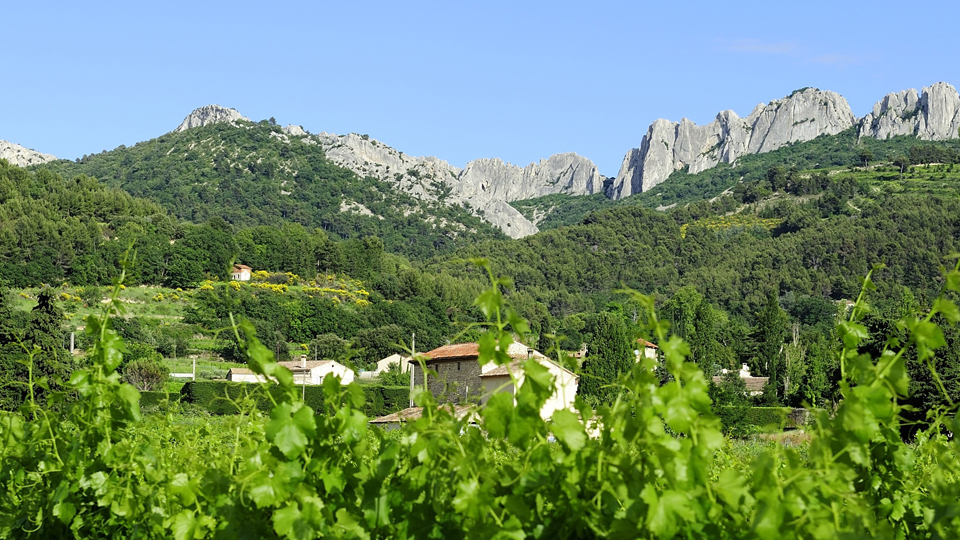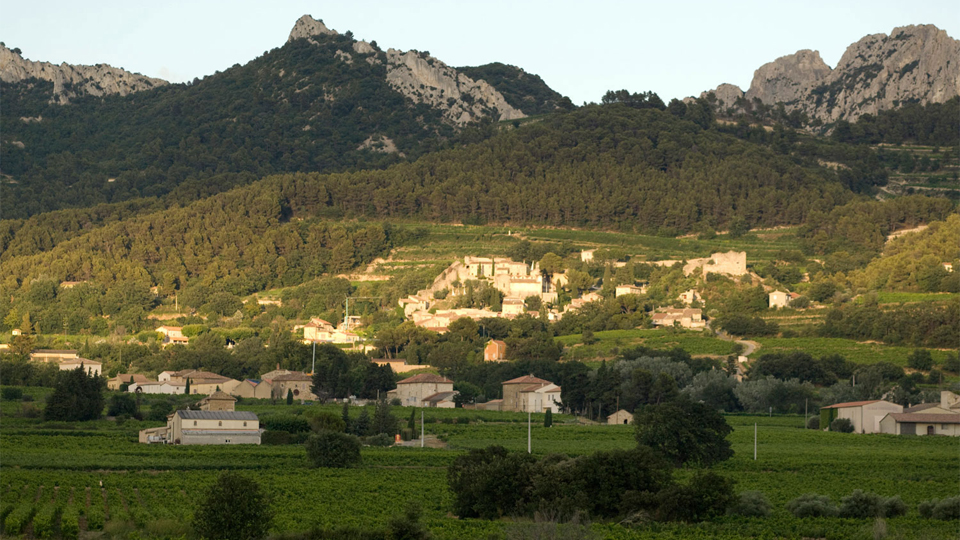Browse using the new Vinous website now. Launch →
Printed by, and for the sole use of . All rights reserved © 2015 Vinous Media
2014 Gigondas Charms While 2015 Stuns
BY JOSH RAYNOLDS | SEPTEMBER 19, 2017
Fans of elegant, accessible southern Rhône wines will find plenty to like from the 2014 Gigondas’ while 2015 produced a plethora of outstanding, attention-grabbing and cellar-worthy wines.
Followed as they are by the often monumental, soon-to-be-legendary 2015s, the 2014s, from a generally difficult vintage, are bound to suffer by comparison, which will inevitably set the stage for price reductions. That’s tough luck for everyone in the supply chain except consumers, who should be able to score some serious deals as numerous fabulous bottlings were made in 2014.

Gigondas and the looming Dentelles de Montmirail
The Southern Rhône’s Graceful Side
The wines of Gigondas are prized by many Rhône fans – this one included – for their relative elegance compared to the usually weightier and higher-octane wines from neighboring Châteauneuf-du-Pape and Vacqueyras. Gigondas relies heavily on Grenache, and typically displays red fruit flavors with floral and spicy lift, a beneficial result of the fact that a large percentage of the appellation’s best vineyards are in cooler, higher-elevation sites. While many producers age the Syrah and Mourvèdre components of their wines in small, sometimes new oak barrels, Grenache is usually fermented and raised in large concrete, stainless steel or neutral oak vats, which allows the fruit to take center stage. Virtually all of the producers I see on my annual visits to Gigondas take great pains to emphasize that they would like their wines to be known for their balance, complexity and finesse rather than for brute strength or flamboyant character. As Thierry Faravel, who makes some of the finest examples of Gigondas (and Vacqueyras, for that matter) at his family’s Domaine la Bouïssiere, told me, “Gigondas isn’t a bulldozer or a monster truck wine; it’s more like a sports car - okay, a sports SUV.”
The Challenges of 2014
Two thousand fourteen was a roller coaster growing season for Gigondas, with a cold, rainy late winter and early spring delaying the budbreak. Temperatures then warmed up to average through the rest of the spring, bringing the vines up to speed and resulting in a normal flowering. But then cool, wet weather returned later in June and pretty much stuck around until late August, when temperatures heated up and allowed the harvest to kick off in mid-September under mostly clement conditions. In fact, the weather was good enough that many growers were able to hold off picking until mid-October, thus allowing their fruit to fully ripen.
One danger in 2014 was the possibility of an overabundant crop, as rainfall totals were above average during late spring and through much of the summer. Attentive farmers kept a close eye on their vines, dropping fruit as needed to eliminate rotten grapes, reduce the overall crop load, and prevent potential dilution in the resulting wines. But given the often painfully short Grenache crop of 2013 it’s not far-fetched to imagine that more than a few growers were willing to give their pruning shears a rest in 2014.

The Dentelles de Montmirail tower over the vineyards of Gigondas
Drink or Hold?
Calling a vintage “forward” in the context of Gigondas doesn’t mean that the wines need to be drunk up soon after release. There’s certainly no rush with the vast majority of the 2014s. While top-notch vintages like 2015, 2010 and 2009 produced an abundance of bottlings that deserve a good decade of patience before showing their best, the 2014s should mostly be drinking well by their fifth birthdays and easily hold for another five years or so. The best wines, well stored, should survive until their fifteenth anniversaries so I wouldn’t feel pressured to pop corks too early.
2015: It’s Another Story Altogether
Two thousand fifteen, along with 2010 and 2005, produced one of the most consistently excellent sets of Gigondas that I’ve ever had the chance to taste. The 2015s are shaping up to be wines of distinct power and depth, with the tannic structure for extended cellaring but with plenty of buffering freshness as well.
Weather conditions were all a grower could hope for from start to finish in 2015. Flowering got off to a fast start and the growing season was warm to hot – but not too hot – and dry, with mostly cool nights, straight through the spring and summer. The disease-free grapes achieved full ripeness with ease and also maintained healthy acidity levels, resulting in wines that are full-flavored without being ponderous and with a compelling interplay of richness and energy. I have no doubt that the wines are set for a long, steady aging curve. Most of the better 2015s will be providing plenty of pleasure well into the 2020s and, in many cases, even the 2030s. I also believe that, because of the harmonious tannins of the wines, the ‘15s will never really shut down hard, which was the case with a number of 2010s and 2005s. If there was ever a southern Rhone vintage worth going wide and long on, ’15 is a winning bet.
I tasted most of the wines reviewed in this article in Gigondas in March and then followed up with many others in New York this spring and summer.
You Might Also Enjoy
2014 and 2015 Vacqueyras: Quality and Value, Josh Raynolds, August 2017
Northern Rhône: Solid ’14 Reds and Outstanding ’15 Whites, Josh Raynolds, July 2017
Châteauneuf-du-Pape Blanc: Moving Out of the Shadows, Josh Raynolds, June 2017
Multimedia: Josh Raynolds on 2015 in the Southern Rhône, Josh Raynolds, June 2017
Multimedia: Josh Raynolds on 2015 in the Northern Rhône, Josh Raynolds, May 2017
Multimedia: Josh Raynolds on Rhône Varietals, Josh Raynolds, April 2017
Multimedia: Josh Raynolds on the Regions of the Rhône, Josh Raynolds, April 2017
The 2015 Northern Rhônes: Outstanding Wines for the Long Haul, Josh Raynolds, April 2017
2015 Châteauneuf-du-Pape: Power and Balance, Josh Raynolds, March 2017
Show all the wines (sorted by score)
- Alain Jaume & Fils
- Arnoux et Fils
- Bergerie de la Plane
- Bonpas
- Brotte
- Caves Saint-Pierre
- Château du Trignon
- Château La Croix des Pins
- Château Redortier
- Clos du Joncuas
- Dauvergne-Ranvier
- Delas Frères
- Domaine Bertrand Stehelin
- Domaine Brusset
- Domaine Cécile Chassagne
- Domaine Cros de la Mûre
- Domaine de Cabasse
- Domaine de Coyeux
- Domaine de Font-Sane
- Domaine de la Mavette
- Domaine de la Tourade
- Domaine de Longue Toque
- Domaine de Piaugier
- Domaine des Bosquets
- Domaine des Espiers
- Domaine des Pasquiers
- Domaine d'Ouréa
- Domaine du Bois des Mèges
- Domaine du Cayron
- Domaine du Gour de Chaulé
- Domaine du Grand Bourjassot
- Domaine du Grapillon d'Or
- Domaine du Pesquier
- Domaine du Pourra
- Domaine du Terme
- Domaine Font Sarade
- Domaine La Bouïssiere
- Domaine La Bouscatière
- Domaine La Fourmone
- Domaine la Haute Marone
- Domaine La Ligière
- Domaine La Roubine
- Domaine La Soumade
- Domaine Le Clos des Cazaux
- Domaine Le Péage
- Domaine Les Chênes Blancs
- Domaine Les Goubert
- Domaine Les Pallières
- Domaine Les Semelles de Vent
- Domaine Les Teyssonnières
- Domaine Montirius
- Domaine Notre Dame des Pallières
- Domaine Palon
- Domaine Raspail-Ay
- Domaine Saint-Damien
- Domaine Saint-Gayan
- Domaine Santa Duc
- E. Guigal
- Famille Perrin
- Famille Tardieu (Tardieu-Laurent)
- Ferraton Père & Fils
- Gabriel Meffre
- Gigondas La Cave
- La Bastide Saint Vincent
- La Compagnie Rhodanienne
- Lavau
- Le Mas des Flauzières
- Louis Bernard
- Maison Bouachon
- Maison Chapoutier
- Moulin de la Gardette
- Ogier
- Olivier & Lafont
- Olivier Ravoire
- Pierre Amadieu
- Pierre-Henri Morel
- Rhonéa
- Saint-Cosme
- Sélection Laurence Féraud
- UVCDR
- Vidal-Fleury
- Vignobles Cheron
- Xavier Vins
